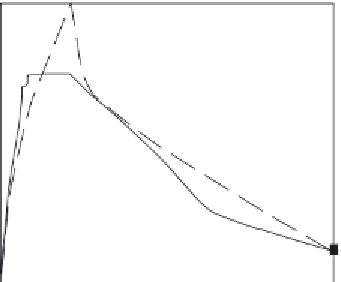Biomedical Engineering Reference
In-Depth Information
25
20
15
10
5
0
0
200
400
600
800
1000
Time (s)
Figure 7.11
Binding of 6 mM glucose to an implantable glucose sensor (Vaddiraju et al., 2008).
coefficient increases by a factor of 28.6 from a value of
k
1
equal to 0.6473 to
k
2
equal to 18.5.
Similarly, for the dissociation phase, as the fractal dimension increases by a factor of 2.48
from a value of
D
fd1
equal to 0.898 to
D
fd2
equal to 2.2282, the dissociation rate coefficient
increases by a factor of 57.87 from a value of
k
d1
equal to 0.0207 to
k
d2
equal to 1.1878. In
both the cases mentioned above, an increase in the degree of heterogeneity on the biosensor
surface (increase in the fractal dimension) leads to a corresponding increase in the rate
coefficient.
Recently,
Pemberton et al. (2009)
have fabricated a microband glucose biosensor using a
screen-printed WB carbon ink and used it for serum analysis. They used this sensor for glu-
cose analysis at 25
C. They optimized the operational pH at 8.0. Steady-state conditions
were determined indicating the presence of radial diffusion.
Pemberton et al.
(
2009
) report that the screen-printing approach has been used for biosensor
fabrication on an industrial mass production scale (
Newman and Setford, 2006
). It is partic-
ularly suitable for the production of low cost disposable devices. They further point out that
they have been successfully employed to make the test strips used by diabetics to monitor
their blood glucose levels (
Matthews et al., 1987
).
Pemberton et al. (2009)
point out that to demonstrate microelectrode behavior using screen-
printing technology with carbon inks, a working electrode of micron size in at least one
dimension is required. Their sensor, fabricated using a solvent-based CoPC-containing
carbon ink, demonstrated microelectrode-type behavior. Their sensor was capable of
exhibiting steady-state current responses in the presence of H
2
O
2
(
Rawson et al., 2007
).


































